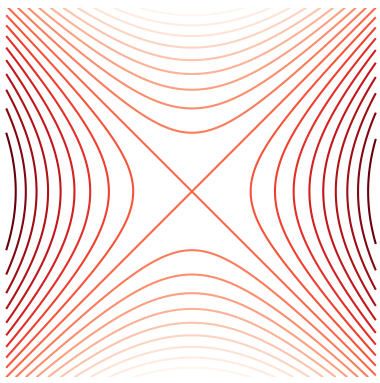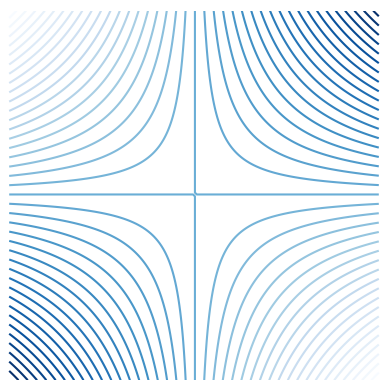
Figure 1: A function defined on a domain $D$ maps each complex number $z \in D$ to a complex number $f(z) \in \C$.
Home | Assessment | Notes | Worksheets | Blackboard
Our main objects of study in this course are complex-valued functions $f$ where the inputs come from a domain $D \subset \mathbb{C}$. We will mainly be interested in differentiating and integrating such functions.

Figure 1: A function defined on a domain $D$ maps each complex number $z \in D$ to a complex number $f(z) \in \C$.
Often, functions are defined by formulae.
More complicated functions such as trigonometric and exponential functions will be formally defined by power series later on in the course. A complex version of the natural logarithm will have to wait until we have discussed integration!
Given a function $f : D \to \C$ we can think of $D$ as a subset of $\R^2$ and of $\C$ as the whole plane $\R^2$. Writing $z = x+iy$ and \[f(z) = f(x+iy) = u(x,y) + i v(x,y)\] lets us think of $f$ as being made up of two real-valued functions $u,v : D \to \R$.
What are the real and imaginary parts of $f(z) = z^2$? Writing $z = x+iy$ we have \[f(x+iy) = (x+iy)^2 = x^2 - y^2 + 2xyi\] so $u(x,y) = x^2 - y^2$ and $v(x,y) = 2xy$.
We cannot easily draw the graph of a function $f : D \to \C$. We conclude this section with a brief discussion of two alternative methods for visualizing such a function.
The first method is to plot the level curves of the real and imaginary parts $u$ and $v$ of $f : D \to \C$. Recall that the level curves of a function $h : D \to \R$ are the curves $h(x,y) = k$ for different values of $k$. We plot level curves in the domain of the function. If the input $z$ is nudged along a level curve of $u$ the real part of the output will not change. Similarly, if the input is nudged along a level curve of $v$ then the imaginary part of the output will not change.


Figure 2: The level curves of the real and imaginary parts $u(x,y) = x^2 - y^2$ and $v(x,y) = 2xy$ of $f(z) = z^2$ respectively.
The second method is to think of $f$ as a vector field on $D$. Indeed, for every $z \in D$ the output $f(z)$ can be thought of as a vector in $\R^2$. Placing the tail of this vector at the point $z \in D$ lets us think of $f$ as a vector field on $D$.
Continuity of functions of a complex variable is much like continuity of functions of a real variable. In this section we define what it means for a function $f : D \to \C$ on a domain to be continuous.
Fix a domain $D \subset \C$. A function $f: D\to\C$ is continuous at a point $c \in D$ if \[\lim_{z \to c} f(z) = f(c)\] holds.
The limit above is formally defined as follows.
Fix a domain $D \subset \C$ and $f: D\to\C$. Fix also $c \in D$. We say that \[\lim_{z\to c} f(z) = \ell\] or that $f(z)$ tends to $\ell$ as $z$ tends to $c$, or that the limit of $f(z)$ exists as $z \to c$ if, for all $\epsilon > 0$, there exists $\delta > 0$ such that if $z \in D$ and $0 < |z-c| < \delta$ then $|f(z)-\ell| < \epsilon$.
That is, $f(z) \to \ell$ as $z \to c$ means that if $z$ is very close and not equal to $c$ then $f(z)$ is very close to $\ell$. Note that in this definition we do not need to know the value of $f(c)$.
Let $f : \C \to \C$ be defined by \[f(z) = \begin{cases} 1 & z \ne 0 \\ 0 & z = 0 \end{cases}\] so that \[\lim\limits_{z\to 0} f(z) = 1\] but $\displaystyle\lim\limits_{z\to 0}f(z) \ne f(0)$. Thus $f$ is not continuous at 0.
Continuous functions of a complex variable obey the same rules as continuous functions of a real variable. Therefore we can use the same strategies for testing and evaluating limits in complex analysis as we used in real analysis.
Suppose that $\displaystyle\lim_{z \to c} f(z) = \ell$ and $\displaystyle\lim_{z \to c} g(z) = m$.
If \[f(z) = a_n z^n + a_{n-1} z^{n-1} + \cdots + a_1 z + a_0\] then $f$ is continuous at every $c \in \C$.
If $f,g$ are polynomials and $g(c) \ne 0$ then \[\lim_{z \to c} \dfrac{f(z)}{g(z)} = \dfrac{f(c)}{g(c)}\]